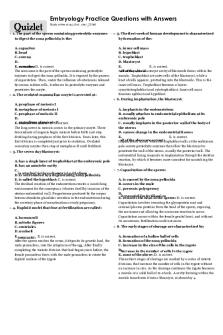13 - Cleft lip and palate - embryology PDF

| Title | 13 - Cleft lip and palate - embryology |
|---|---|
| Course | Biology |
| Institution | The Chancellor, Masters, and Scholars of the University of Cambridge |
| Pages | 2 |
| File Size | 74.7 KB |
| File Type | |
| Total Downloads | 70 |
| Total Views | 121 |
Summary
This is a compilation of notes that I wrote to help me revise for the anatomy exam....
Description
Cleft lip and palate - embryology
Cleft lip and cleft palate = birth defects that occur when a baby's lip or mouth do not form properly during pregnancy Craniofacial malformations Often due to defects in neural crest cell development which affects typical development of the face 2) Development of the face Face develops during 7th and 8th week of life by fusion of 5 processes Fusion of five neural crest filled bulges of ectoderm: all are derived from mesenchyme of 1st arch, except fronto-nasal process 1) Unpaired medial frontonasal process —> divided into lateral and medial nasal processes (on each side by future nostrils), carries infratrochlear nerve laterally and external nasal nerves medially 2) Bilateral maxillary swellings carries Vb 3) Bilateral mandibular swellings — carries Vc End of 4th week: stomodeum forms centre of face - surrounded by first pharyngeal arches Differentiation of structures derived from these swellings depends on epithelial-mesenchymal interactions
Although primary palate derived from intermaxillary segment, main part of definitive palate is the secondary palate Formed by palatine shelves (medial extensions of maxillary swellings) which fuse at the midline Palatine shelves appear in week 6, directed obliquely downwards on each side of tongue Week 7: palatine shelves ascend to attain horizontal position above tongue and fuse in midline to form secondary palate Growth of this secondary palate depends on survival and proliferation of neural crest derived and mesoderm derived cells of pharyngeal arch
Clinical: anomalies in fusion of 5 facial swellings (due to defects in neural crest cell development, most of the time) causes facial clefts Cleft lip: maxillary swelling fails to form with medial nasal process Cleft palate: incomplete fusion of palatine shelves e.g. they’re too small, inhibition of fusion process itself, or failure of tongue to drop between shelves
Severity: a) anterior clefts - could be barely visible or as bad as lip extending into nose b) posterior clefts - cleavage of uvula only to cleavage of entire secondary palate Defects in neural crest cell development Most of the time, defects in NC cell development is the cause of these facial clefts Results in other defects and syndromes such as Treacher Collins and DiGeorge’s syndrome TC syndrome - rare, 1:50,000 births, autosomal dominant mandibulofacial dysostosis syndrome Causes under-development of facial bones and mandible + can cause abnormalities of the palate i.e. cleft palate(!!!!!!), abnormalities in external ears, atresia of external auditory meatus, irregular/absent middle ear ossicles —> bilateral conductive hearing loss Due to deficit of neural crest cells in 1st and 2nd arches —> caused by mutation in TCOF1 gene (implicated in ribosome biogenesis, chromosome segregation and the regulation of oxidative stress) TCOF1 mutation causes apoptosis in neural tube - depletes pool of pre migratory NC cells, reduced proliferation of migrating NC cells Defects in external ear and external auditory meatus due to 1st and 2nd arch defects - because external ear develops from 6 auricular hillocks on apposed surfaces of 1st and 2nd pharyngeal arch, whilst 1st pharyngeal cleft (between 1st and 2nd arches) forms EAM. Insert diagram: Prevention: treating mothers with antioxidants - maternal antioxidant dietary supplementation Holoprosencephaly Cause: FAS (foetal alcohol syndrome) - most cases due to alcohol consumption within 1st month of pregnancy when forebrain induction takes place - therefore disturbs early induction of forebrain Most common cause of mental retardation in western world Dramatic defects in facial structures arising from the frontonasal process The medial nasal processes fail to form, resulting in agenesis of the intermaxillary process and reduction or absence of other midfacial structures, e.g. the nasal bones, nasal septum and ethmoid. Can cause midline cleft palate Consequence may be a single nostril (cebocephaly), close-set eyes (hypotelorism) or even a single eye (cyclopia)...
Similar Free PDFs

LIP Bumper
- 7 Pages

Embryology Final
- 143 Pages

embryology summary
- 15 Pages

Cleft Sentence Exercise
- 1 Pages

Lip lab - Riassunti
- 2 Pages

Embryology pdf
- 12 Pages

Embryology Practice Questions
- 16 Pages

LIP Bumper - Nota: 10
- 4 Pages

Lip Bumper - Odontopediatria
- 5 Pages

Histology embryology Lab 5
- 13 Pages

ANAT1001 Embryology questions
- 3 Pages
Popular Institutions
- Tinajero National High School - Annex
- Politeknik Caltex Riau
- Yokohama City University
- SGT University
- University of Al-Qadisiyah
- Divine Word College of Vigan
- Techniek College Rotterdam
- Universidade de Santiago
- Universiti Teknologi MARA Cawangan Johor Kampus Pasir Gudang
- Poltekkes Kemenkes Yogyakarta
- Baguio City National High School
- Colegio san marcos
- preparatoria uno
- Centro de Bachillerato Tecnológico Industrial y de Servicios No. 107
- Dalian Maritime University
- Quang Trung Secondary School
- Colegio Tecnológico en Informática
- Corporación Regional de Educación Superior
- Grupo CEDVA
- Dar Al Uloom University
- Centro de Estudios Preuniversitarios de la Universidad Nacional de Ingeniería
- 上智大学
- Aakash International School, Nuna Majara
- San Felipe Neri Catholic School
- Kang Chiao International School - New Taipei City
- Misamis Occidental National High School
- Institución Educativa Escuela Normal Juan Ladrilleros
- Kolehiyo ng Pantukan
- Batanes State College
- Instituto Continental
- Sekolah Menengah Kejuruan Kesehatan Kaltara (Tarakan)
- Colegio de La Inmaculada Concepcion - Cebu




